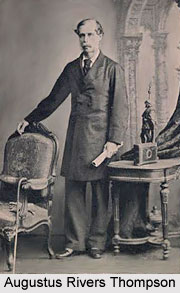 Sir Augustus Rivers Thompson KCSI CIE, popularly known as Augustus Rivers Thompson, acted as a Lieutenant Governor of Bengal Presidency from the year 1882 to 1887, in undivided India under the rule of the British East India Company. He was also one of the most renowned colonial administrators. Thompson, born in the year 1829, was appointed as the Chief Commissioner of the British Crown Colony of Burma in April and held the position till March 1878.
Sir Augustus Rivers Thompson KCSI CIE, popularly known as Augustus Rivers Thompson, acted as a Lieutenant Governor of Bengal Presidency from the year 1882 to 1887, in undivided India under the rule of the British East India Company. He was also one of the most renowned colonial administrators. Thompson, born in the year 1829, was appointed as the Chief Commissioner of the British Crown Colony of Burma in April and held the position till March 1878.
Sir Augustus Rivers Thompson was appointed as the Lieutenant Governor of Bengal Province in the year 1882 and was succeeded by Sir Ashley Eden KCSI CIE. The Bengal Presidency originally comprised east and west Bengal and was a colonial region of the British Empire in India. The region included the territories of undivided Bengal like West Bengal, Tripura, Orissa, Meghalaya, Bihar, Assam and modern Bangladesh. Sir Augustus Rivers Thompson KCSI CIE served in office till the year 1887 and was succeeded by Sir Steuart Colvin Bayley GCSI, CIE.
Augustus Rivers Thompson was knighted with Companion of the Most Exalted Order of the Star of India (CSI) in 1877 and Companion of the Most Eminent Order of the Indian Empire (CIE) in the year 1883. He was later honoured with Knight Commander of the Most Exalted Order of the Star of India (KCSI) in 1885.
This article is a stub. You may enrich it by adding more information to it. You can send your write-up at content@indianetzone.com



















